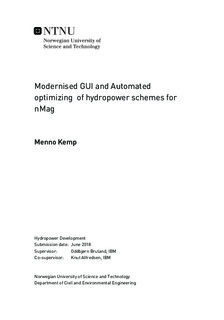| dc.description.abstract | During the last decades of the twentieth century various tools to simulate water systems have been developed. One of these tools is ENMag, a simulator that models a single reservoir. Later, in the 1990 s as a continuation of its predecessor, nMag was created. This newer version allows multiple reservoirs to be simulated. As data had to be written in text files which were read by nMag, setting up a simulation could be tedious. To improve this, a user interface had been developed. It acts as a data editor and presenter.
nMag is used mostly for prefeasibility studies, environmental effect analyses and educational purposes. All of these uses become more important in the future as the energy market in Norway is changing. Old hydropower schemes must be upgraded and new ones must be build. A lot of studies use or could use a general purpose, easy-to-use simulator.
The current user interface of nMag has become outdated and is not user friendly. This can be problematic, especially for educational purposes. Combined with the fact that nMag is not capable of running automatic optimisations, there is a demand for an upgrade.
The objective of this thesis is to develop a new UI for the nMag simulator. This UI must also include an optimiser and a method of visualising the water system. During design and development, intuitive and convenient user interaction should be the main focus.
The software has been designed with extension in mind for future features and changes. Python was selected as the programming language because of its low learning curve and usage within NTNU. As the NMag program has become quite large and complex, C# has replaced Python to ensure that the code stays structured and maintainable.
To visualise the water system an algorithm has been developed that places the components in a grid creating connections between them. This visual interface of the system is the main mechanism to switch between the components.
For systems with multiple reservoirs and complex connections there are a lot of parameters that have to be set to the right value to find the optimal use. Optimisation of the water system is done by using a genetic algorithm. A set of potential solutions is modified and evaluated. From each set, the best solution is chosen and used to create the next set. When a certain criteria is met the iteration stops and the best solution is reported.
Testing the optimisation on a single reservoir hasn t shown any promising results. When using it on a more complex system, the algorithm was able to find a better operation strategy than the standard balancing function of nMag. Improving the algorithm and tuning the evolution parameters will increase the effectiveness of this new feature.
This new UI already demonstrated the new possibilities. It should, however, be continuously tested and improved to reach its full potential. | |

